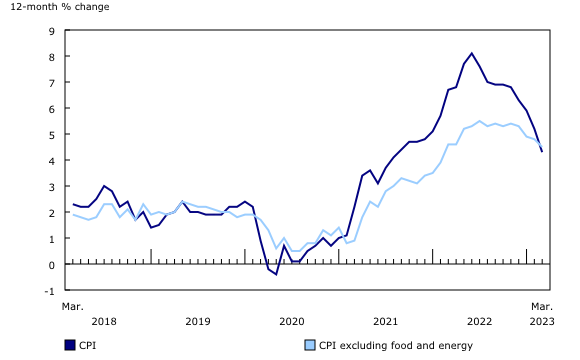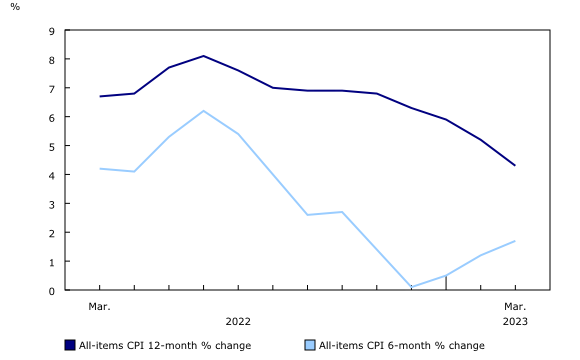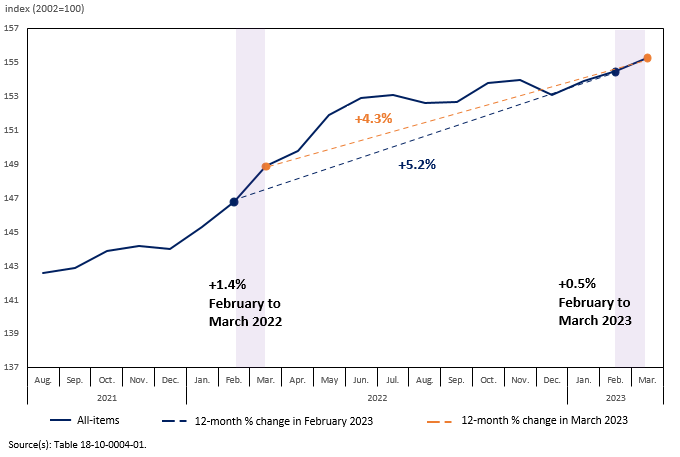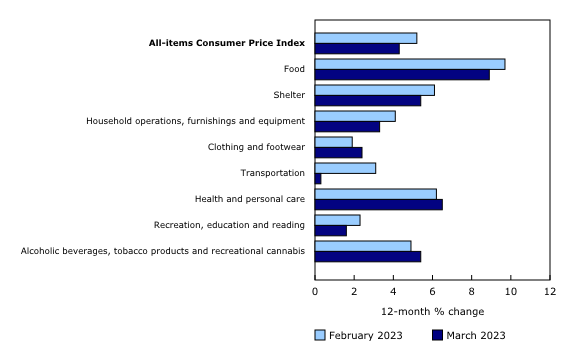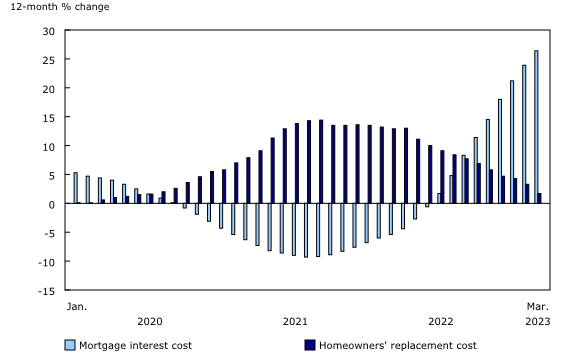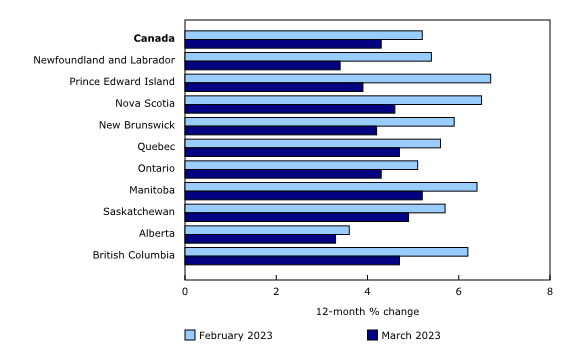Consumer Price Index, March 2023
Released: 2023-04-18
March 2023
4.3% 
(12-month change)
The Consumer Price Index (CPI) rose 4.3% year over year in March, following a 5.2% increase in February. This was the smallest increase since August 2021 (+4.1%). On a year-over-year basis, Canadians paid more in mortgage interest costs, which was offset by a decline in energy prices.
As a result of the steep monthly increase in prices in March 2022 (+1.4%), base-year effects, notably gasoline prices, continued to have a strong downward impact on consumer inflation, contributing to the year-over-year deceleration in March 2023.
Excluding food and energy, prices were up 4.5% year over year in March, following a 4.8% gain in February, while the all-items CPI excluding mortgage interest cost rose 3.6%, after increasing 4.7% in February.
On a monthly basis, the CPI was up 0.5% in March, following a 0.4% gain in February. Travel tours (+36.7%) contributed the most to the headline month-over-month movement, largely driven by increased seasonal demand during the March break. On a seasonally adjusted monthly basis, the CPI rose 0.1%.
While headline inflation has slowed in recent months, having increased 1.7% in March compared with 6 months ago, prices remain elevated. Compared with 18 months ago, for example, inflation has increased 8.7%.
Base-year effects and the headline Consumer Price Index
The Consumer Price Index (CPI) is a standard measure of the price of a representative basket of goods and services. The headline consumer inflation is measured as the percentage change between the CPI in the current month (March 2023) and the CPI in a base month or the same calendar month of the previous year (March 2022).
A base-year effect refers to the impact that price movements from 12 months earlier have on the current month's headline consumer inflation. When a large 1-month upward price change in the base month stops influencing—or falls out of—the 12-month price movement, this has a downward effect on headline CPI in the current month. Conversely, when a large 1-month downward price change in the base month falls out, this creates upward pressure on the current month's 12-month figure.
In the first half of 2022, the global economy was affected by the Russian invasion of Ukraine and Canadian consumers experienced a significant increase in prices from January to June 2022. Headline consumer inflation increased from 5.1% in January to 8.1% in June 2022. The broad increase in prices in the early months of 2022, stemming from energy, durable goods and wheat-based food products, had a downward impact on the year-over-year rate of consumer inflation in March 2023. This is because higher prices from March 2022 were used as the basis for year-over-year comparison.
Price increases observed in the first half of 2022 will continue to fall out of the 12-month price movement. While inflation has slowed in recent months, prices remain elevated. Users should consider the impact of base-year effects when interpreting the 12-month price movement.
Gasoline prices fall year over year for the second consecutive month
Gasoline prices dropped year over year for the second consecutive month in March (-13.8%), the largest yearly decline since July 2020. The fall in gasoline prices was mainly driven by steep price increases in March 2022, when gasoline rose 11.8% month over month as a result of supply uncertainty following Russia's invasion of Ukraine. This increased crude oil prices, which pushed prices at the pump higher for Canadians.
Price growth for durable goods slow on base-year effects
On a year-over-year basis, price growth for durable goods slowed in March (+1.6%) compared with February (+3.4%). Furniture prices led the deceleration in prices for durable goods, falling 0.3% year over year in March, following a 7.2% increase in February. The decline was largely due to a base-year effect, as prices for furniture rose 8.2% month over month in March 2022 amid supply chain issues.
Prices for passenger vehicles also contributed to the deceleration in prices for durable goods, increasing at a slower pace year over year in March 2023 (+4.7%) compared with February (+5.3%). Higher prices for passenger vehicles in March 2022, as a result of the global shortage of semiconductor chips, put downward pressure on the index in March 2023.
Month over month, new passenger vehicle prices were up 1.3% in March, attributable to the higher availability of new 2023-model-year vehicles. For comparison, prices for used vehicles rose 0.6% month over month in March, after a 1.9% decline in February.
Homeowners' replacement cost slows, while mortgage interest cost rises at the fastest pace on record
Homeowners' replacement cost continued to slow in March, rising 1.7% year over year compared with a 3.3% increase in February, reflecting a general cooling of the housing market.
In contrast, mortgage interest cost rose at a faster rate in March (+26.4%) compared with February (+23.9%). This was the largest yearly increase on record as Canadians continued to renew and initiate mortgages at higher interest rates.
Grocery prices increase at a slower pace
Year over year, prices for food purchased from stores rose to a lesser extent in March (+9.7%) than in February (+10.6%), with the slowdown stemming from lower prices for fresh fruit and vegetables.
Prices for fresh fruit increased 7.1% year over year in March, after a 10.5% gain in February. Prices for grapes and oranges contributed the most to the deceleration.
Similarly, fresh vegetable prices slowed year over year in March (+10.8%) compared with February (+13.4%), mainly driven by prices for cucumbers and celery.
Explore the Consumer Price Index tools
Check out the Personal Inflation Calculator. This interactive calculator allows you to enter dollar amounts in the common expense categories to produce a personalized inflation rate, which you can compare to the official measure of inflation for the average Canadian household—the Consumer Price Index (CPI).
Visit the Consumer Price Index portal to find all CPI data, publications, interactive tools, and announcements highlighting new products and upcoming changes to the CPI in one convenient location.
Browse the Consumer Price Index Data Visualization Tool to access current (Latest Snapshot of the CPI) and historical (Price trends: 1914 to today) CPI data in a customizable visual format.
Find the answers to the most common questions about the CPI in the context of the COVID-19 pandemic and beyond.
Regional highlights
Year over year, prices rose at a slower pace in March compared with February in every province. Price growth slowed the most in Atlantic Canada, as a result of lower prices for fuel oil and other fuels, which is more commonly used to heat homes in that region than in other provinces.
Rent prices increase in Manitoba
In Manitoba, lower prices for gasoline and durable goods were offset by higher prices for rent in March. Rent prices in Manitoba rose 8.2% on a year-over-year basis, marking the fourth consecutive month of increases above 5%, as rental demand outpaces supply amid population growth.
Note to readers
New approach to estimating the sub-indices of the digital computing equipment and devices index
The computer equipment, software and supplies index and the multipurpose digital devices index, which are sub-indices of the digital computing equipment and devices index, are now updated with an enhanced methodology and new data sources. A technical paper describing the new approach is available, Measuring the price of digital computing equipment and devices in the Consumer Price Index.
Consumer Price Index basket update in June 2023
The Consumer Price Index (CPI) is based on a fixed basket of goods and services designed according to international standards and methods. On June 20, 2023, updated basket weights for the goods and services used in the calculation of the CPI will be made available in table 18-10-0007-01. The new basket weight reference period will be 2022, based on the most recent household final consumption expenditure data and other alternative data. The methods and data sources used will be similar to the last basket update in June 2022.
One week later, on June 27, 2023, the May CPI will be released, based on the updated basket weights.
For general information on basket updates, consult The Canadian Consumer Price Index Reference Paper, chapter 8, "Weights and basket updates."
Real-time data tables
Real-time data table 18-10-0259-01 will be updated on May 1. For more information, consult the document "Real-time data tables."
Next release
The CPI for April will be released on May 16.
Products
The "Consumer Price Index Data Visualization Tool" is available on the Statistics Canada website.
More information on the concepts and use of the Consumer Price Index (CPI) is available in The Canadian Consumer Price Index Reference Paper (62-553-X).
For information on the history of the CPI in Canada, consult the publication Exploring the First Century of Canada's Consumer Price Index (62-604-X).
Two videos, "An Overview of Canada's Consumer Price Index (CPI)" and "The Consumer Price Index and Your Experience of Price Change," are available on Statistics Canada's YouTube channel.
Find out answers to the most common questions posed about the CPI in the context of COVID-19 and beyond.
Contact information
For more information, or to enquire about the concepts, methods or data quality of this release, contact us (toll-free 1-800-263-1136; 514-283-8300; infostats@statcan.gc.ca) or Media Relations (statcan.mediahotline-ligneinfomedias.statcan@statcan.gc.ca).
- Date modified:

